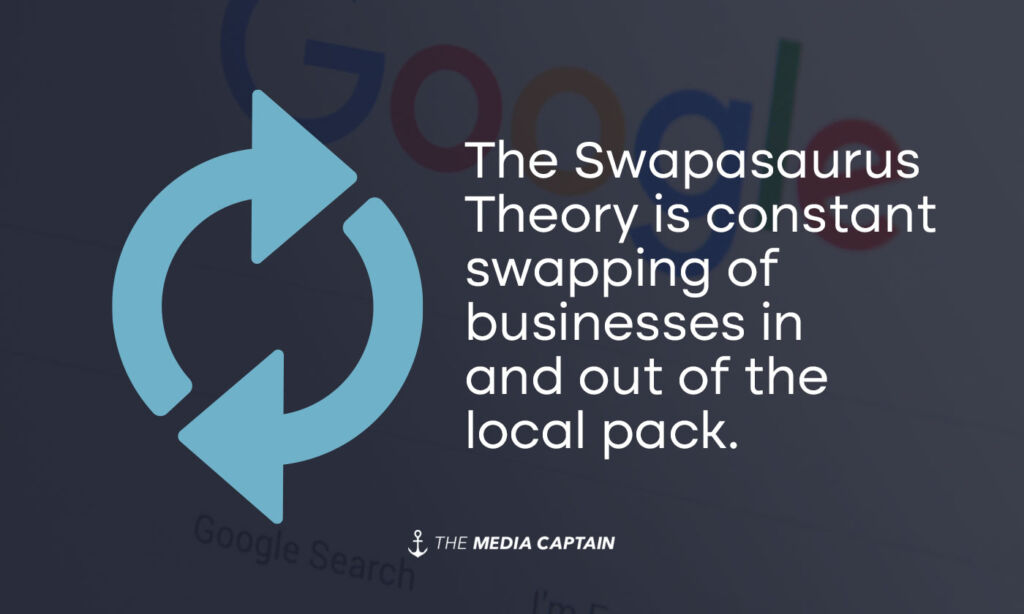If you are a local business and closely monitor your Google Map rankings, November has likely been a stressful month due to massive volatility.
One day your business is ranking #2 in the local results, the next day you’ve been completely wiped off the map only to recover a couple of days later.
Joyanne Hawkins dubbed Google’s newest local algorithm update as “Bedlam” due to massive rank changes of local listings.
As of November 26th, 2019, the volatility hasn’t stopped. If Google is rolling out an algorithm, it’s taking a hell of a long time, which is where my Swapasauraus Theory comes from.
What is Swapasaurus?
Note: Due to confusion of the theory amongst the SEO community, the section below was updated on November 29th:
The Swapasaurus Theory is constant swapping of businesses in and out of the local pack. Rather than three businesses becoming a mainstay as the top three ranked businesses in the local pack, there’s other businesses that will swap in and out. There’s also constant swapping of positioning amongst businesses in the local pack. For example, your business can be ranked #2 in the local pack on one search and if you conduct the same search an hour later, you can be in the #3 position.
Search Engine Roundtable published the Swapasaurus theory and in the headline of the article stated the following: “While position #1 remains stable, #2 and #3 are subject to more volatility.”
From the data we’ve analyzed, we have seen more fluctuation and volatility amongst positions 2 and 3 than position 1. That being said, we’ve seen fluctuation with the #1 position also. The focus of this theory should be the constant swapping of businesses in and out of the local pack and the swapping of positioning amongst businesses in the local pack.
Why the Swapasaurus Theory Makes Sense
A local algorithm update is extremely stressful for local businesses because you are either in or out of the exclusive club. There are only three listings that prominently display in Google’s map results below the search bar. If you are #4, tough luck, but not a lot of people are going to find you.
In most instances, there’s more than 3 legitimate businesses per industry per local market.
What if Google decided that the three Google Map rankings that were displayed weren’t a mainstay? They were essentially going to swap in and out different local businesses at different times?
This is where my Swapasaurus theory comes from. The algorithm has been going on for such a long time (nearly a month) that it’s possible the constant volatility (and swapping) is here to stay. At what point do we stop saying we’re in the midst of an algorithm update and admit that this constant fluctuation/swapping is the new norm?
Note: There are different ways to state a business is swapping in and out of the local pack. For the sake of this theory, I’ve referred to it as swapping. Rotating, Moving In and Out, Swapping, Fluctuating and Dropping (to name a few) are all sufficient ways of stating the same thing, which is that there’s constant movement taking place amongst the local pack rankings.

Interesting Trends/Findings
Our agency tracks local rankings for over 50 local clients so we have a lot of data at our disposal. Below are some trends we’ve noticed:
- The company that’s ranking #1 in Google’s map rankings hasn’t experienced nearly as much volatility as position 2 and 3.
- From what we’ve analyzed, having a keyword in the Google My Business title has benefited many businesses and spam has definitely not been reduced.
- We have seen instances where the #1 ranked is experiencing volatility and dropping in and out of the local map results, we just haven’t seen nearly as much volatility as positions 2 and 3 (see example 2 below).
- Positions 2 and 3 are experiencing the real bedlam.
- The real volatility we’ve seen is happening amongst positions 2 and 3.
- Google often swaps out position 2 or position 3 for a nearby business… If you are conducting a search in a suburb, for example, Google will show a business nearby that will replace the #2 or #3 ranking.
- There are days when the #2 or #3 ranked position in Google Maps completely drops out of the local results only to recover a couple of days later.
- In many instances, (including example one below) there are 4 legitimate business fighting for position #2 and #3 and being constantly swapped in and out.
Examples
Below is an example of a lawn care company we track local rankings for via SEMRush. You can see the #1 position has been constant over the past 30-days (they have a keyword heavy GMB title). The bedlam has been between 4 other businesses fighting for position 2 and 3. There’s been days when search visibility for a company goes from above 30% all the way to 0% and then back up.
Example 2
Below is an example of an attorney we represent and the fluctuation that has taken place. This screenshot shows that there’s still fluctuation amongst the #1 ranked company but there’s been less fluctuation compared to their competitors who weren’t ranking #1. Still, the #1 company is experiencing crazy volatility, but when it goes down, it only stays down for a short timespan.
Note: We initially included an example of a bankruptcy attorney we represent but the chart was hard to understand due to the fact that we weren’t tracking the company ranking in the #1 position in the local pack over a 30-day timespan. We removed that reference and replaced it with the one below on November 29th, 2019.

Conclusion
There have been many great theories about Bedlam. Swapasaurus is just another theory that businesses could swap in and out into the top three Google Map rankings, especially as this fluctuation has continued onward for nearly a month. More position swapping amongst businesses ranking in the local pack could also be here to stay.
Could it be that Google doesn’t want three businesses to own the Google Map rankings as they feel more businesses should get equal exposure?
November ’19 has been a nerve-racking month for local business owners. Hopefully there is clarity in the near future.





